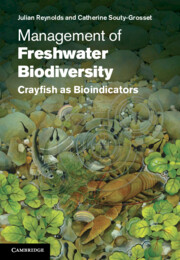Book contents
- Frontmatter
- Contents
- Preface
- Acknowledgements
- Introduction: Biodiversity in freshwater systems, and the key roles played by crayfish
- Part I The present situation of crayfish in world freshwater ecosystems
- 1 Crayfish in the decapod lineage, their natural distribution and their threatened status
- 2 Why are crayfish, among freshwater decapods, considered pivotal in freshwater ecosystems?
- 3 Crayfish as prime players in ecosystems
- 4 Human-mediated threats to crayfish survival
- 5 Crayfish exploitation systems
- Part II Applying science to conservation management
- Part III Knowledge transfer for successful crayfish management
- References
- Glossary
- Index
- Scientific and common English names of well-studied crayfish featured in this book
- Common English and scientific names of well-studied crayfish featured in this book
- Plate section
2 - Why are crayfish, among freshwater decapods, considered pivotal in freshwater ecosystems?
from Part I - The present situation of crayfish in world freshwater ecosystems
Published online by Cambridge University Press: 05 December 2011
- Frontmatter
- Contents
- Preface
- Acknowledgements
- Introduction: Biodiversity in freshwater systems, and the key roles played by crayfish
- Part I The present situation of crayfish in world freshwater ecosystems
- 1 Crayfish in the decapod lineage, their natural distribution and their threatened status
- 2 Why are crayfish, among freshwater decapods, considered pivotal in freshwater ecosystems?
- 3 Crayfish as prime players in ecosystems
- 4 Human-mediated threats to crayfish survival
- 5 Crayfish exploitation systems
- Part II Applying science to conservation management
- Part III Knowledge transfer for successful crayfish management
- References
- Glossary
- Index
- Scientific and common English names of well-studied crayfish featured in this book
- Common English and scientific names of well-studied crayfish featured in this book
- Plate section
Summary
The roles of crayfish, crabs and other decapods in fresh waters
In contrast to sea shores, freshwater habitats often seem to lack excitement and interest, although both may be biodiverse. Most freshwater invertebrates are small or cryptic, and usually only discovered by sweep-netting. The largest aquatic insects, including some water beetles, belostomatid bugs, water-measurers and odonates, nearly all have a winged adult phase, for survival or dispersal. In contrast, many freshwater decapod crustaceans – the lobster-like freshwater crayfish, brachyuran freshwater crabs and various ‘shrimps’ – are sharply different, and more like denizens of marine rock pools. All stages are homotopic, aquatic or semi-aquatic, and most adults are larger – often much larger – than insects or other crustaceans. Unlike their decapod relatives the primarily tropical freshwater crabs, crayfish are predominantly temperate, only extending into the tropics in North and Central America, in Madagascar and in Australasia, where they tend to live at higher altitudes than in the temperate zone (Hobbs, 1987). In addition to their large size, crayfish are often long-lived compared with other invertebrates, enhancing their significance in many freshwater systems.
The number of freshwater crayfish species is more than 650, but the exact total is as yet undetermined. There are twice as many species of freshwater crab (Cumberlidge et al., 2009), reflecting their high levels of endemism in the tropics. Crayfish make an especially impressive contribution to freshwater ecosystems in two regions of the world because of their diversity, size, longevity and varied ecology; a point that will be developed in the next chapter. More than 400 cambarid species occur in North America in a wide variety of habitats, many tolerating broad temperature ranges, e.g. Orconectes rusticus (2.5°–33°C) and Procambarus clarkii (up to 35°C), and the continent also supports a few cool-water indigenous astacid species, again with broad temperature tolerances (see Table 2.1). Australia has upwards of 100 parastacids of hugely varying sizes and ecological specializations, extending from cool temperate to tropical latitudes, and including burrowing forms that live far from open water. South America and Madagascar also have suites of parastacids that use a range of habitats, from cool forest streams to warm swamps. In contrast, Europe has only five indigenous species (Souty-Grosset et al., 2006), all Astacidae, all living in streams, ponds and lakes, and all with relatively similar life histories.
- Type
- Chapter
- Information
- Management of Freshwater BiodiversityCrayfish as Bioindicators, pp. 45 - 58Publisher: Cambridge University PressPrint publication year: 2011
- 1
- Cited by



